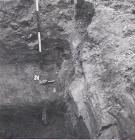1
"Then came the invitation for me to undertake locating and excavating the old Moravian town of Fairfield on the Thames, made famous in 1812 War with the retreat of Proctor and the death of Tecumseh. Preparation, planning and arranging the financing was undertaken by the University. Dr. Fred Landon, Mr. Arthur Ford and Dr. James Talman were the chief negotiators. The Moravian Mission was taken over by the United Church. Mr. MacNicol, M.P. was the principal spokesman. My first contact with the venture was when Mr. Landon, Mr. Ford, Dr. Talman and Mr. MacNicol drove to the supposed site in a field beside Hutberg Moravian Cemetery. Fortune was with me. After looking the land over I went across #2 Highway, dug some test holes and came up with a brass compass, nails and uncovered a cornerstone, all in a few minutes. Those finds clinched the decision, gave them confidence in my surmise. Things developed after that and on an early April (1942) morning I found myself on the way to the Hotel in Thamesville where it was arranged I would live while I did my research at Fairfield" (Wilfrid Jury, 1972 autobiography).2
Wilf at Fairfield site, a Moravian missionary, 1792-1813circa 1942-1947
Bothwell, Ontario, Canada
 Credits:
Credits:Museum of Ontario Archaeology
3
Wilf completed major excavations at Fairfield between 1942 and 1947, although his work there was somewhat sporadic as he intermixed it with many other Museum and personal activites. This was the firs site Wilf excavated that had archival data. By combining the information from historic maps and journals with the archaeological data he uncovered, he was able to provide a fair interpretation of what the site looked like and what took place there. The site of Fairfield had been established in 1792 by Pennsylvania-based Moravian missionaries, Brother Zeisberger and Senseman, with fellow Moravians and a group of Delaware Indians fleeing the United States; it was the first Protestant mission in Upper Canada. The missionaries laid out their village with a definite plan, a street lined with cabins surrounding the centrally-located church and schoolhouse on a scenic terrace overlooking the Thames River. The documents recorded that at times up to 200 people occupied this bustling village. Wilf's fieldwork conclusively demonstrated the existence of two very different types of dwellings: the houses of the missionaries had root cellars, windows and doors with hardware, whereas those of the Delaware did not.4
Excavation at Fairfield sitecirca 1942-1947
Bothwell, Ontario, Canada
 Credits:
Credits:Museum of Ontario Archaeology
5
During the War of 1812, the Fairfield mission site was visited and temporarily occupied by both British and American troops. In early October 1813 the opposing forces clashed in the Battle of the Thames a short distance west of the mission. The British retreated and the Americans took over the mission village, burning it to the ground on October 7, 1813.Even before Wilf had sunk a shovel in the Fairfield site, he had developed a keen interest in the life and times of Tecumseh. This interest grew even more as a result of Fairfield and the historical documentation he and Elsie compiled on the events in that area during the War of 1812 which culmiated in the death of the famous Shawnee warrior during the battle along the Thames River on October 5, 1813. During his time at Fairfield, Wilf began an unsuccessful search for Tecumseh's grave. Wilf got side-tracked with other projects in the late 1940s, but in 1949 he made a plea to develop the search for Tecumseh into a major project. Wilf came to devote his time and efforts to other matters, and the Tecumseh project was shelved. He did however maintain an interest in it, and a 1967 London Free Press feature on Wilf focussed in part on his efforts to locate Tecumseh's grave.